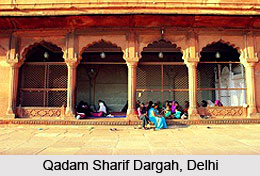 Qadam Sharif is a Dargah in the area of Paharganj in North Delhi and comprises a tiny tomb complex which was established during 1375 to 1376 CE. It also possesses a shrine, a `madrasa` and a mosque, all protected by a massive wall, equipped with a large gateway. It is situated at the north-western end of the New Delhi Railway Station, inside urban settlements. Located close to it is existent an U-shaped structure which contains the ruins of the seven mosques of the Wazir Khan-i-Jahan Maqbul Tilangani or Khan Jalan which belonged to Firoz Shah Tughlaq.
Qadam Sharif is a Dargah in the area of Paharganj in North Delhi and comprises a tiny tomb complex which was established during 1375 to 1376 CE. It also possesses a shrine, a `madrasa` and a mosque, all protected by a massive wall, equipped with a large gateway. It is situated at the north-western end of the New Delhi Railway Station, inside urban settlements. Located close to it is existent an U-shaped structure which contains the ruins of the seven mosques of the Wazir Khan-i-Jahan Maqbul Tilangani or Khan Jalan which belonged to Firoz Shah Tughlaq.
History of the Qadam Sharif
Qadam Sharif was created by Firoz Shah Tughlaq and it is a marvellous rectangular tomb, surrounded by huge walls and large gates, which follows the architectural style of the Tughlaq. He had modified the tomb to be utilized by his son after the death of his son Fateh Khan in the year 1376. The tomb also possesses a stone on which is engraved the footprints of Prophet Muhammad which was imported from Mecca by Firoz Shah Tughlaq. The words `Qadam Sharif` means `Footprint of the Prophet` as per the English language. In the inner part of the tomb complex is based at madrasa and also a mosque.
From centuries, the whole area has been absorbed by accommodation and commercial buildings, even though the tomb, most of the walls are still clearly visible. In addition, the madrasa and mosque at the tomb are still actively used, and the foot print is an important pilgrimage site.
This article is a stub. You can enrich by adding more information to it. Send your Write Up to content@indianetzone.com



















